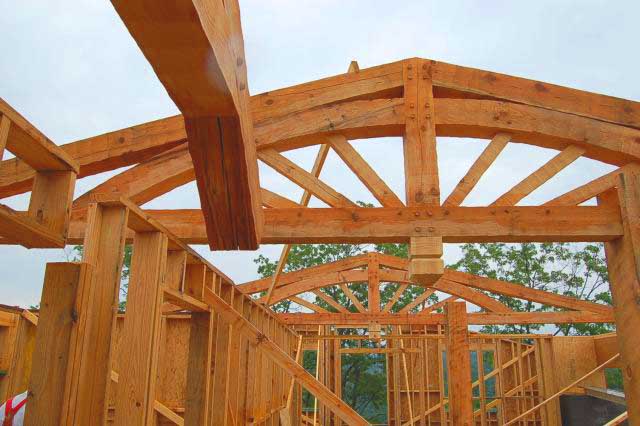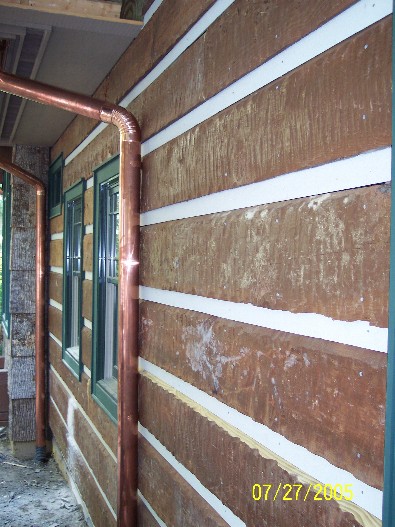
Log homes have interested people in the United States since the European discovery of the continent and the subsequent pioneering-settlement era over the last several hundred years. At present there are a multitude of log home fabricators and a tremendous interest in log homes from the public. The treatment of log home materials, log home technology and log protection are an important consideration of the preparation of any log structure. Other aspects include the desired aesthetic expression and methods of installation. And due to the wider thickness of logs, they can dramatically impact the space required when floor planning and structurally organizing a log home project. All of these items impact the value, required maintenance and enjoyment of a log house design.
LOG HOME TECHNOLOGY, LOG PROTECTION, DESIGN AND INSTALLATION
Rand Soellner AIA / NCARB 828. 743. 6010
Log Homes Have Lots of Appeal Built Into Them
 There is something appealing in the basics of log home technology. Many people enjoy the massive proportions, warm colors, chunky textures and permanent-look of a log home. My experience has been that the large visual proportions of some log home designs substantially exceed the structural requirements of the building or home. One of the mistakes I have seen some designers make is to use little sticks of wood, like 4×4’s, to support portions of homes and in some instances, portions of log homes. Even though these smaller pieces of lumber may accomplish the structural job, they are not visually resolved. I call this effect: “Holding up an elephant with toothpicks.” Builders, in particular, seem to have difficulty with this issue in log homes and other structures, as they are trying to help their clients economize. While this is an admirable objective and I am sure much-appreciated by their clients, the result is severely damaging to the aesthetic perception of the building. See my website for examples of my more muscular treatments of this situation.
There is something appealing in the basics of log home technology. Many people enjoy the massive proportions, warm colors, chunky textures and permanent-look of a log home. My experience has been that the large visual proportions of some log home designs substantially exceed the structural requirements of the building or home. One of the mistakes I have seen some designers make is to use little sticks of wood, like 4×4’s, to support portions of homes and in some instances, portions of log homes. Even though these smaller pieces of lumber may accomplish the structural job, they are not visually resolved. I call this effect: “Holding up an elephant with toothpicks.” Builders, in particular, seem to have difficulty with this issue in log homes and other structures, as they are trying to help their clients economize. While this is an admirable objective and I am sure much-appreciated by their clients, the result is severely damaging to the aesthetic perception of the building. See my website for examples of my more muscular treatments of this situation.
Soellner home architects performed an analysis of this on a front porch of a log home design with the cooperation of one of the log home builders with whom he works, and he was surprised to find that the difference between our large timber way of supporting it compared with the least expensive method using tiny sticks that were visually unappealing was about $3,500. The appraised impact of these larger members was approximately $75,000 in increased value. A good investment, there! Log home technology can actually help you deal with such situations, as logs are inherently larger than typical construction materials. To create a good log home design, one should embrace this fact: logs are large. Use them.
 A “log” home can have all-log walls, just some log posts, or a combination of thereof, which will impact the cost of the log home. Some of the log homes we create are hybrids, utilizing log home techonology. We often use real log walls and also use another material we invented: Faux Logs, or log siding (the subject of another log home article in this series) which is being demonstrated on the Falcon Cliff Lodge in Cashiers, North Carolina.
A “log” home can have all-log walls, just some log posts, or a combination of thereof, which will impact the cost of the log home. Some of the log homes we create are hybrids, utilizing log home techonology. We often use real log walls and also use another material we invented: Faux Logs, or log siding (the subject of another log home article in this series) which is being demonstrated on the Falcon Cliff Lodge in Cashiers, North Carolina.
Whichever type of logs you decide to use, it is important to use the best log home technology to treat them chemically to prevent them from damage from rain, snow and insects. How do we accomplish this? The best solution is to use pressure-treated wood. Unfortunately, it is expensive to move big logs around and difficult to find facilities large enough in which to treat large posts and beams. Often it is easiest to harvest logs from the site or nearby and often these logs may be of white pine or other softwoods, which means they are susceptible to damage. It is important to have the bark removed promptly, because insects love to burrow in under it where they are protected from the environment, while they munch away on your wood.
One of the most economical log home technology treatments to use on logs when pressure treatment is not reasonably available, is to spray or paint the debarked logs with boric acid. Terminix tells me that powder post beetle larva cannot handle it in their digestive tracts and that it also assists in making the wood unappealing to carpenter ants and boring bees, all creatures that can make mincemeat of your wonderful log home design. While Terminix will not officially document the following, some field technicians have told me that boric acid can also be effective at controlling termites (that is unofficial and undocumented anecdotal information that may or may not help you with your circumstances).
There are also finishing treatment that the log homeowner, builder and log home architect need to consider. Log home technology offers a variety of finish coatings to consider. You really should Not simply expose logs to the weather, unless you have some sort of superwood that has a positive track record in this situation (perhaps Siberian Larch). Most logs, much of them white pine, will eventually rot down to the ground, unless you coat them with some sort of protecting paint-on or spray-on liquid stain with protecting elements in it. Sikkens Cetol is probably the Rolls Royce of such treatments and this is at least a 3-stage process and it is not cheap, but it does appear to deliver a flexible quality coating that protects. There are considerations of visual slickness of surface to evaluate, as this does create a satin sheen on the wood surface. Australian Timber Oil from Cabot’s is a fall back option that is a one-stage operation (which means it costs less). It is absorbed more like standard stain into the log surface, but probably will not as effectively protect the logs like the Sikkens product will. There are multitudes of other products that log home technology vendors offer to use on your log structure.
Log Home Technology and Construction Techniques
Some people have looked at my log homes and asked me: “How did you ever get these enormous logs into place here on this cliff face, so high off the ground?” Well, after spending years with builders who do this for a living every day of their lives, you learn a few things. Large cranes with long booms and substantial counterweights help a lot, as do people who are experienced in setting logs. Make no mistake, this is mountain-man-sized-work, and is nothing the inexperienced should try. Only use people whom are experienced in log home technology, in putting together log homes and heavy timbers should do this. Proper scaffolding provides elevated platforms on which to work to set the logs in place as well.
Large roof overhangs are essential, in my opinion. I would actually consider this to be on aspect of log home technology. This approach can be seen on many historic log homes that remain standing today, having stood the test of time. It comes down to protection: protect those logs and especially the log walls, which are the main component of most log houses. The easiest, most cost effective way to do this is to extend your roof edge out at least a couple of feet, so that direct rainfall and snow doesn’t continuously challenge the integrity of your log walls.
Protect the ends of log beams that are otherwise exposed. This is one aspect of log home technology that I happened to have invented. One of my clients had a 17-year old log kit home from one of the major log home manufacturers. Unfortunately, some of the walls had log beam elements that projected out from the structure and were exposed to the weather. Nothing whatsoever protected their ends. I noticed, upon examination, that the little capilliaries in the wood had done a very good job of sucking water through them, even after felling and being dead and being placed into a log structure. Unfortunately, this was not good for my client’s home.

These little capillaries are part of a tree’s vascular tissue and are called xylem and phloem. These little “straws” transport fluids and nutrients internally in a tree (and any plant). They are very good at doing this, so much so, that continue to do so, even after being cut, treated and incoporated into a building. Why is this important?
Because exposed large log beam ends act like straws, wicking in external environmental moisture right into the structure. In my client’s case, his old log home (which I did not design) had drawn water through such unprotected log beam ends up to 30″ into his log walls. We had to have the builder use special liquid fiberglass injection to replace the damaged and rotten materials, after a careful structural examination by a licensed structural engineer. So, there is some biology and science to log home technology, as well as construction. You need to understand the nature of the materials with which you are working and what they will do naturally and whether or not you want to allow them to do those things or not.
What do I do about this particular situation? I have a trademark treatment for this situation, in which I have the build coat the ends of the log with polyurethane sealant liberally to encapsulate the tiny wood capillaries, then immediately cover this gooey surface with a copper plate, hammered back along the shaft of the log beam for a few inches. In log home technology terms, the copper is pretty much there as a permanent decorative shield. The real work is being done by a high-quality flexible sealant.
Comparative Log Home vrs. Conventional Frame Insulation
Many people seem surprised to find that log home technology really does not deliver as great an “R” insulation value as they had supposed. For instance, fir, pine and other softwoods typically have an “R” value per inch of thickness of about 1.25. This means that the typically 6″ thick wall log has an “R” value of 7.5. Compare this with the R-15 found in Rand Soellner home architects project 2×4 walls, or the R-19 to R-21 in our 2×6 wall homes. In other words, some people wish to achieve a much higher R-value using frame construction with a log-look. Our faux log treatment (log siding) solves this problem. We also work with clients who want real log walls, sometimes using double-wythe walls to achieve this goal of greater insulation.
Log Home Architects Designs Continue to Have Market Appeal
Log houses will continue to be of interest into the foreseeable future and we receive calls from around the world to design log homes. Please give us a call if you have any questions. Log home technology is an evolving art as much as it is science. All of the tips on this webpage should only be undertaken with the advice and counsel of a licensed architect who evaluates your particular circumstances prior to your obtaining materials and attempting anything discussed herein. Only contractors licensed to perform the above procedures should attempt to accomplish them handling chemicals and other log home technology features can be dangerous and deadly. This is heavy, heavy construction and the other aspects of log home construction require that only professional be involved in their preparation and assembly.
Rand Soellner is willing to prepare custom log home designs for you, your special lifestyle and your unique building site. Log home architects are those special professionals who can design your custom house to your particular requirements.
To discuss log home design, log home technology, log home architecture and log home design-build, please contact Rand Soellner, Architect at: 828-269-9046 or 828-269-9046 or e-mail us at: rand@homearchitects.com
Our website is: www.HomeArchitects.com
This article will be of interest to people looking for information on:
log home technology
log home architects
log home engineering
log construction
design-build
American log homes
historic log homes
modern log homes
home architects
custom home architects
mountain home architects
